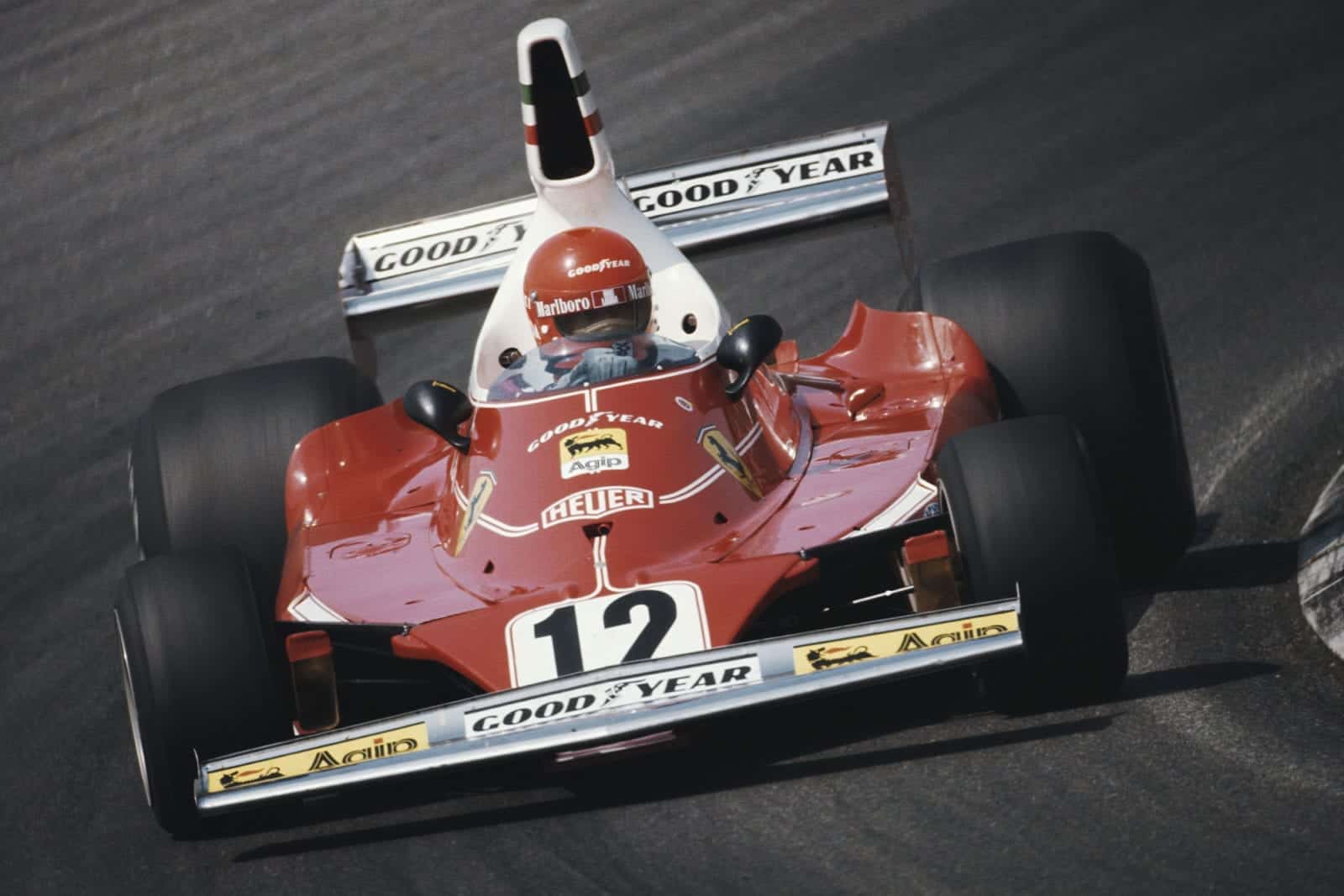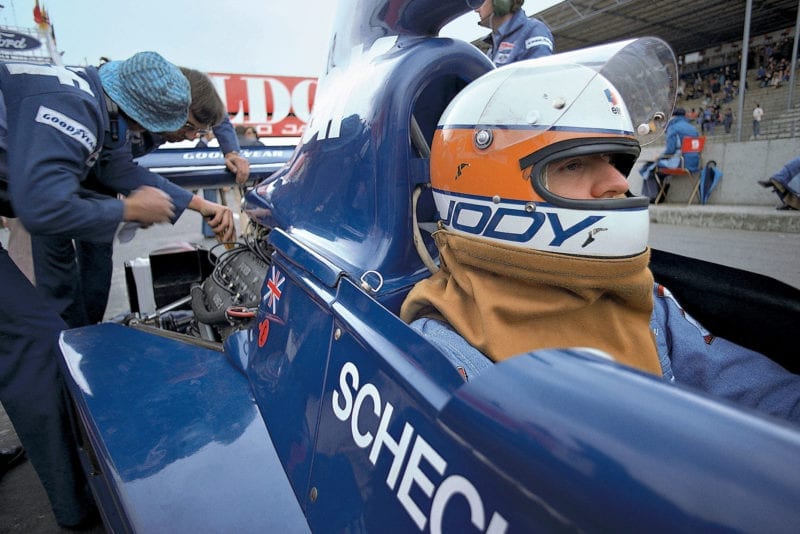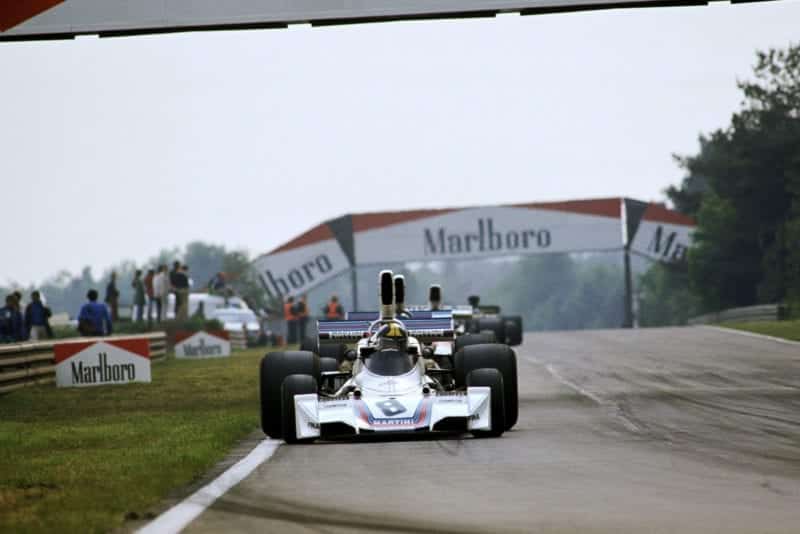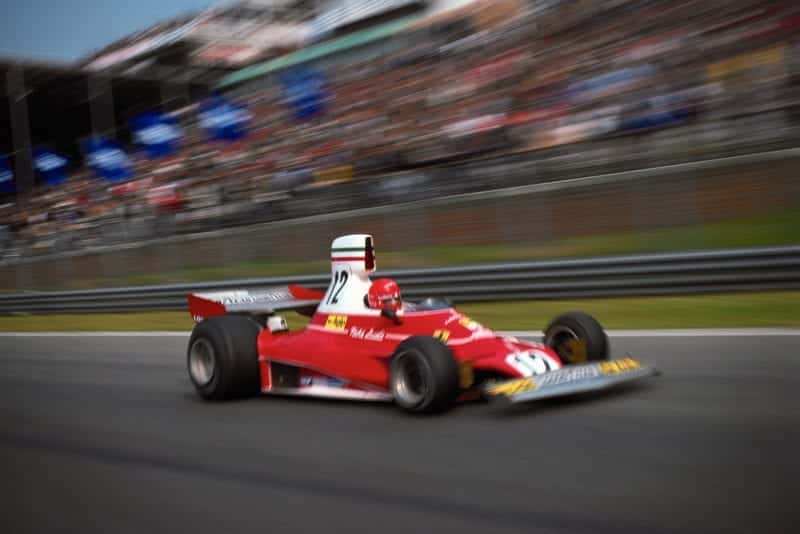1975 Belgian Grand Prix race report

Ferrari's Niki Lauda emerged victorious for a third win of the season
Motorsport Images
Another Ferrari domination Terlamen, Zolder, May 25th
Two years ago the Belgian Grand Prix was held on the little Zolder circuit before it was really ready to accept the full onslaught of the Grand Prix “circus” and the result was a shambles, to say the least. Most of the teams and drivers stamped off saying they wouldn’t come back, while one or two people said “You know, apart from the surface breaking up, it wasn’t such a bad little race”. Time is a great healer and in 1975 the “circus” returned in force and this time the Zolder circuit was ready for them and everything went smoothly. Time is such a great healer that the President of the GPDA is even suggesting that the Belgian Grand Prix might one day return to the Spa-Francorchamps circuit in the Ardennes, always assuming the circuit owners want them back.
The Zolder circuit is a strange little place, quite friendly and attractively set in pine woods on a sandy soil with the self-contained paddock area in the middle, the two straight sections of the circuit running up and down on each side of the paddock area. The twisty bits at each end are not very challenging and don’t call for any great driving skills or screwing-up of courage on the part of the drivers and while they are interesting to spectators they are not exactly exciting to watch. Whereas previously there was a fast ess-bend leading on to the pits straight there had now been built a tight ess-bend calling for heavy braking and a scrabble round the left/right corners and acceleration up a slight incline. Although the lap speed is quite high (over 110 m.p.h.) it is very much a “scratcher’s circuit” in the idiom of the Brands Hatch Club circuit and anyone prepared to throw caution to winds and scrabble round in a pretty untidy fashion can make a respectable lap time; neat and tidy driving was not an essential ingredient for a good lap time. During the weekend some of the “scratchers” embarrassed some of the established stars, as they would at Mallory Park or Lydden Hill. While the event had the makings of an amusing Formula One race it was hard to view it as the Grand Prix of Belgium and certainly not a Grande Epreuve, unless we are prepared to lower our standards.
It would appear that some of the drivers could not really sum it up as a circuit, for writing in Motor, Lauda said “. . . Zolder is a circuit where overtaking isn’t too difficult”, while Hunt said “. . . although passing is very difficult at Zolder . . .” At least they knew their own minds.
Qualifying
Scratching round began on Friday morning for some drivers, Lauda being in a hurry from the word go, while Fittipaldi looked to be on form and Jarier was out to show who was number one in the Shadow team. Brambilla was getting on with the job with enthusiasm in the works March and Brise was pressing on in the Hill car as if it was a Formula Atlantic car, but bearing in mind the remark he made after his brief drive in a Williams in the Spanish GP about knowing now what people mean when they talked about “part throttle”. Shortly before the lunch break Lauda’s Ferrari split one of the titanium exhaust pipes on the new system, so the car was lifted bodily up onto trestles in front of the pits and the old system put back. Mark Donohue continued his crashing ways in the Penske car and had to miss the afternoon session while it was repaired, but Francois Migault was able to join in after lunch as the brand new Hill car was completed. It was not taking long for those who were trying hard to find that their brakes were suffering as there was little time for the discs to cool off between applications. There was a lot of ducting taking cold air to the discs, but little in the way of attempts to get the hot air away from the discs, while some of the air scoops seemed to be at direct variance with the designer’s theories on airflow, if his aids to down-force from air-flow were to be taken seriously. Some of the Cosworth V8 engines were giving trouble and Pryce had to use the spare Shadow and Pace had to use the first of the spare Brabhams, with which he made his fastest time of all. The number one BRM ran into engine trouble so Evans had to use the spare car and as it seemed to he going welI he stuck with it for the rest of the meeting.
By the end of the first day of practice everything was running very smoothly, apart from the GPDA having a union-meeting at exactly the same time as Martini had organised a pleasant little gathering for the Press to meet the Brabham-Martini team and chat informally to Reutemann and Pace. We were left high and dry (with a Martini) while Mr. Ecclestone apologised for the absence of his drivers. John Watson remarked in Motoring News that the GPDA “. . . had room for improvement on the PR side”. He wasn’t joking.

Jody Scheckter prepares to head out on track
Motorsport Images
As Carlos Pace was fastest on the first day of practice there were a lot of people who wanted to talk to him. Lauda was next fastest followed by Fittipaldi and Scheckter. Well up the list in ninth place was Brambilla, while Brise was eleventh, ahead of a lot of people who should be able to out-drive him with one hand in their pocket. It all started up again on Saturday morning, but before anyone had got into the groove a slight misty drizzle enveloped the circuit turning the surface into a skating rink, as Brambilla and Migault quickly discovered. Most of the others had scuttled into the pits, changing to wet-weather tyres and waiting for the rain to develop into something serious. This it did not do and everyone sat around saying it was too slippery to carry on with “slick” tyres, and not wet enough to use “wet weather” tyres, and anyway there was nothing to learn, so practice fizzled out like the proverbial damp squib. Ickx went out for a few laps (almost by tradition, as someone remarked) and Lauda did one tentative reconnaissance lap. Peterson had blown a big hole in his Cosworth V8 engine, as had Hunt, so the unofficial cessation of practice was welcome to them. The practice times did not mean too much, except that those who pressed-on regardless found themselves at the top of the list and cautious ones were lower down than normal. Naturally none of the times were anywhere near the previous day’s.
After lunch it dried up completely and practice got going again in real earnest, with Brambilla’s enthusiastic driving paying off with second fastest time for the day, sandwiched between the two Ferraris. Joining them in the elite 1 min. 25 sec. bracket was Tom Pryce, another example of youthful enthusiasm embarrassing some established stars, while Brise moved up to sixth place on the day’s reckoning. Peterson had a new engine in his Lotus and Emerson Fittipaldi made very little progress in spite of a lot of juggling with bits and pieces and various adjustments. When the sum total of times of the few sessions were analysed, for grid positions, Lauda was on pole position yet again, with Pace alongside him. Brambilla earned himself a big “double-A for effort” with third fastest time, ahead of Regazzoni, which was going to take some explaining away back in Modena. Another driver to earn a double-A was Tony Brise, in seventh place, ahead of World Champion Fittipaldi, while Alan Jones earned a single A for effort, with thirteenth place, ahead of Peterson. Unusual was the sight of John Watson, well down the field; there was nothing wrong with the Surtees but somehow the bearded Ulsterman could not “get with it”, though he hoped it would all come right once the race started. Race day was rather dull and overcast, but at least there was no sign of rain, and most drivers took advantage of the 30 minutes of testing-time in the morning to try their cars in full race trim. As fastest man in practice Lauda had been given the choice of which side of the 2 x 2 grid he preferred, and he chose the left side as the first corner after the start was a sharp left-hander at which they would all arrive at a lower speed than normal, from the standing start. This meant he could hug the inside line, making anyone who tried to overtake go round the outside.
Race

The field crowds into Turn One
Motorsport Images
Before the cars came out for their warm-up laps the drivers were taken round on a parade-lap standing up through the sunshine roofs of small Fiat saloons. This was well received by the crowds who lined the circuit, many drivers having thick pockets of fans among the crowds, who cheered lustily. Italian, Austrian and British flags could be seen at various points around the public enclosures, as well as many Ferrari Club banners. The starting grid held an air of tension, with Lauda determined to beat Pace into the first corner, even though the Brabham is noted for getting its Cosworth power down onto the road well. In the second row Brambilla and Regazzoni, side-by-side, were causing some people to stand well back and the rest of the grid were waiting to see what was going to happen ahead of them.
It was an excellent start for the 70-lap race, with the Ferrari and the Brabham wheel-to-wheel down to the first corner, with Regazzoni on the outside making it a trio and Brambilla right behind them. Pace carved nearly across in front of Lauda, snatching the corner from him and led round the long loop leading to the back straight, with Brambilla nipping by Regazzoni. Everyone got round the first corner safely, with Merzario tailing along in the rear having nearly burnt his clutch out on the line. Down the back straight it was still Pace leading Lauda as they braked for the ess-bend behind the pits. In mid-field Jochen Mass got out of control in his McLaren going into the esses and in the subsequent melee Watson damaged the nose of the Surtees, while Laffite hit Alan Jones up the back and wrecked the rear aerofoil mounting and punctured an oil radiator on the Hesketh. The result of all this was that Mass went no further, Jones retired at the pits, Laffite stopped to have the nose cowling of the Williams patched up with tape, and Watson continued with the nose of the Surtees out of shape, subsequently stopping after 11 laps to have another nose fitted.
On the second lap Lauda was very close to the rear of Pace’s Brabham, wondering if he could get by, when he saw Brambilla charging up behind. Knowing the race had only just begun he moved over to let the March go scrabbling by, the enthusiastic Brambilla nearly going off the road as he went by into second place. Pace now found that the Brabham was not handling to his liking, something technical to do with the tyres, and Brambilla charged by into the lead, amidst cheers from everyone for the swarthy Italian is a likeable fellow, even though he is not World Champion material. He was well aware that he was unlikely to be able to keep this pace up for the whole race, nor would his brakes last that long, but he was determined to have his glory while he could. He led for laps 4 and 5 in a hectic display of “real scratching”, watched from behind by Lauda, who had pushed his way by Carlos Pace going into the corner after the pits. On lap 6 Lauda decided the comedy had gone on long enough and sailed past the March with ease and was away into the lead. It was now all over for the Ferrari driver dominated the race from then on, pulling steadily away from everyone and looking extremely confident. The fast but rather uncertain Niki Lauda of 1974 has matured and no longer looks about to make a mistake and uses the Ferrari to the full. It was noticeably more stable under heavy braking compared to rival makes and Lauda had no difficulty in maintaining the lead for the rest of the race.

Carlos Pace lead early on
Motorsport Images
All the happenings took place behind him, and occasionally in front of him as he lapped the slower cars. On lap 7 Scheckter carved his way past Pace, and though he drove hard and at times untidily, the South African was no threat to the leading Ferrari, even though he ousted Brambilla from second place on lap 9. By ten laps the scene had settled down with Lauda well out in front, followed by Scheckter and Brambilla with Regazzoni leading the rest of the field. Brise had been in the thick of things in the bunch behind the leading trio, but overdid his braking into the eases behind the pits, spun and stalled the engine and took a long time to get restarted. Merzario had lasted no time at all with his slipping clutch and parked the Williams out on the circuit and walked back to the pits. In mid-field there was quite a nose-to-tail battle going on with Pace trying desperately to hold off Reutemann, Pryce, Fittipaldi, Javier, Hunt, Depailler and Peterson. At the back of the field Evans was keeping ahead of Migault and Donohue, and had bravely led Ickx for quite a time. Regazzoni eventually asserted his superiority and got his Ferrari in front of Brambilla’s March and Emerson Fittipaldi showed signs of settling in to the race and moving up the field from his lowly eighth position. The effort of getting past the March overheated a front tyre on Regazzoni’s Ferrari and he was forced to stop after 17 laps for a change. This left Lauda and Scheckter way out on their own and dropped Regazzoni down to twelfth, behind the B.R.M. Jarier ploughed off into the rough at the second ess-bend and the Shadow stayed there, covered in sand, while his team-mate Pryce was passed by Depailler and Peterson.
Pace’s Brabham was now in trouble with its Hewland gearbox, third gear becoming elusive, so that he was steadily elbowed back down the field. While Lauda sliced his way through the back markers without losing time, Scheckter got hung up on occasions and the Ferrari disappeared from his view. Some way back Brambilla was still holding a valiant third place, driving for his life as Reutemann, Fittipaldi, Depailler, Peterson, Pace and Pryce chased after him. Retirements were still rife, Hunt dropping out with the gearbox of his Hesketh breaking away from the control rod in the cockpit, Brise retiring with a very broken engine in the Hill car, Lella Lombardi having an oil connection break and leak all the oil away, causing the engine to seize and Laffite disappearing from the back of the field with a broken gearbox on the Williams. For a while things stabilised, with no signs of any exciting changes, but then Peterson found a lack of brakes at the ess-bend behind the pits and went straight-on into the catch-fences out of the race. On a circuit with so little challenge in it there was little hope of seeing any inspired Grand Prix driving, though Depailler was pressing hard on the tail of Fittipaldi’s McLaren, trying to pick the moment to take fourth place away from the World Champion. At 49 laps Brambilla had a tyre suffering on his March and stopped for a change, which not only lost him third place, but also the ignominy of having all and sundry overtake him for the brakes on the March were running out. In ninth place Regazzoni was the last not lapped by Lauda and when Brambilla rejoined the race it was just ahead of the second Ferrari, so Regazzoni had two objectives to spur him on. One was to catch Brambilla and the other was to avoid being lapped by Lauda; if he failed on both counts it would take some explaining to the Commendatore, for both Ferraris were running strongly. Pace was falling back steadily and was now at the end of the runners who were on the same lap as Lauda but was lapped by him on lap 54 just as Brambilla had to retire with a complete lack of brakes. On lap 58 the leading Ferrari split an exhaust manifold pipe, which made it sound ragged but did not lose it any speed and at the same time Fittipaldi’s McLaren was running out of front brakes and Depailler was able to swoop by into a well-deserved fourth place behind Reutemann, who had annexed third place mostly by reason of other driver’s misfortunes. Breakages were still occurring for Migault went by with his left rear wheel at a peculiar angle, the suspension having broken, and Ickx had a busy low-speed moment when the left front brake shaft broke on his Lotus. Fittipaldi was going slower and slower with fewer and fewer brakes, and his elder brother was trying to keep his own car going to the finish, though like the leading Ferrari it had a broken exhaust manifold pipe. In second place in the closing laps, Scheckter’s Tyrrell began to run short of petrol and he only just made it to the finish. In his successful endeavour to avoid being lapped by his team-mate, Regazzoni recorded the fastest lap, a new record for the revised circuit.

Lauda’s scored another win for the Scuderia
Motorsport Images
Lauda finished the 70 laps a confident winner, his second victory in succession, well satisfied with the 1975 Ferrari and proclaiming it to be a more stable and better car than its rivals apart from any horsepower advantage it might have. It wasn’t a very inspiring Belgian Grand Prix and certainly not a memorable one, but at least it was free of political wrangles, a nice change.—D.S.J.
Results : BELGIAN GRAND PRIX—Formula One-70 laps—Zolder-4.262 kilometres per lap-298.34 kilometres
